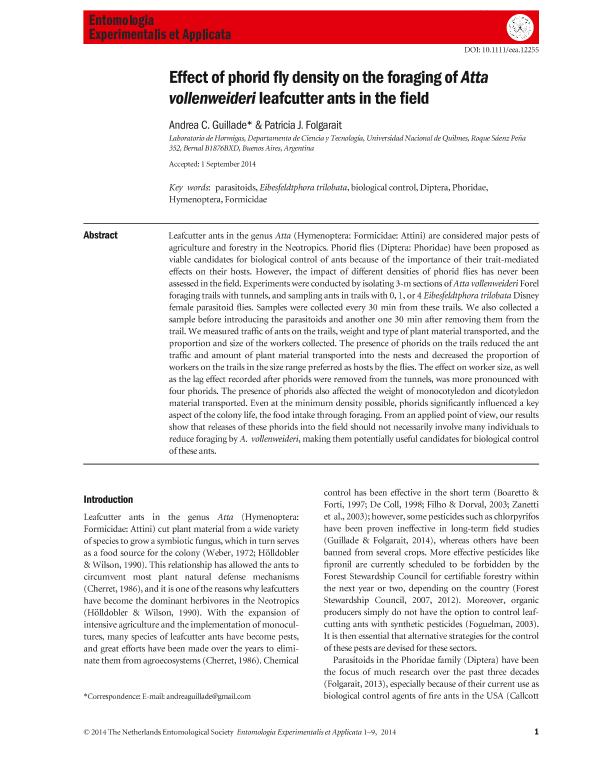Mostrar el registro sencillo del ítem
dc.contributor.author
Guillade, Andrea Cecilia

dc.contributor.author
Folgarait, Patricia Julia

dc.date.available
2020-06-19T14:11:25Z
dc.date.issued
2015-01
dc.identifier.citation
Guillade, Andrea Cecilia; Folgarait, Patricia Julia; Effect of phorid fly density on the foraging of Atta vollenweideri leafcutter ants in the field; Wiley Blackwell Publishing, Inc; Entomologia Experimentalis et Applicata; 154; 1-2015; 53-61
dc.identifier.issn
0013-8703
dc.identifier.uri
http://hdl.handle.net/11336/107699
dc.description.abstract
Leafcutter ants in the genus Atta (Hymenoptera: Formicidae: Attini) are considered major pests of agriculture and forestry in the Neotropics. Phorid flies (Diptera: Phoridae) have been proposed as viable candidates for biological control of ants because of the importance of their trait-mediated effects on their hosts. However, the impact of different densities of phorid flies has never been assessedinthe field. Experimentswere conductedby isolating3-m sections ofAttavollenweideri Forel foraging trails with tunnels, and sampling ants in trails with 0, 1, or 4 Eibesfeldtphora trilobata Disney female parasitoid flies. Samples were collected every 30 min from these trails. We also collected a sample before introducing the parasitoids and another one 30 min after removing them from the trail. We measured traffic of ants on the trails, weight and type of plant material transported, and the proportion and size of the workers collected. The presence of phorids on the trails reduced the anttraffic and amount of plant material transported into the nests and decreased the proportion of workers on the trails in the size range preferred as hosts by the flies. The effect on worker size, as well as the lag effect recorded after phorids were removed from the tunnels, was more pronounced with four phorids. The presence of phorids also affected the weight of monocotyledon and dicotyledon material transported. Even at the minimum density possible, phorids significantly influenced a key aspect of the colony life, the food intake through foraging. From an applied point of view, our results show that releases of these phorids into the field should not necessarily involve many individuals to reduce foraging byA. vollenweideri, making them potentially useful candidates for biological control of these ants.
dc.format
application/pdf
dc.language.iso
eng
dc.publisher
Wiley Blackwell Publishing, Inc

dc.rights
info:eu-repo/semantics/openAccess
dc.rights.uri
https://creativecommons.org/licenses/by-nc-sa/2.5/ar/
dc.subject
PARASITOIDS
dc.subject
EIBESFELDTPHORA TRILOBATA
dc.subject
LEAFCUTTER ANTS
dc.subject
BIOLOGICAL CONTROL
dc.subject
DIPTERA
dc.subject
PHORIDAE
dc.subject
HYMENOPTERA
dc.subject
FORMICIDAE
dc.subject.classification
Zoología, Ornitología, Entomología, Etología

dc.subject.classification
Ciencias Biológicas

dc.subject.classification
CIENCIAS NATURALES Y EXACTAS

dc.title
Effect of phorid fly density on the foraging of Atta vollenweideri leafcutter ants in the field
dc.type
info:eu-repo/semantics/article
dc.type
info:ar-repo/semantics/artículo
dc.type
info:eu-repo/semantics/publishedVersion
dc.date.updated
2020-06-18T15:11:04Z
dc.journal.volume
154
dc.journal.pagination
53-61
dc.journal.pais
Reino Unido

dc.journal.ciudad
Londres
dc.description.fil
Fil: Guillade, Andrea Cecilia. Universidad Nacional de Quilmes. Departamento de Ciencia y Tecnología. Laboratorio de Hormigas; Argentina. Consejo Nacional de Investigaciones Científicas y Técnicas; Argentina
dc.description.fil
Fil: Folgarait, Patricia Julia. Consejo Nacional de Investigaciones Científicas y Técnicas; Argentina. Universidad Nacional de Quilmes. Departamento de Ciencia y Tecnología. Laboratorio de Hormigas; Argentina
dc.journal.title
Entomologia Experimentalis et Applicata

dc.relation.alternativeid
info:eu-repo/semantics/altIdentifier/doi/http://dx.doi.org/10.1111/eea.12255
dc.relation.alternativeid
info:eu-repo/semantics/altIdentifier/url/https://onlinelibrary.wiley.com/doi/abs/10.1111/eea.12255
Archivos asociados
